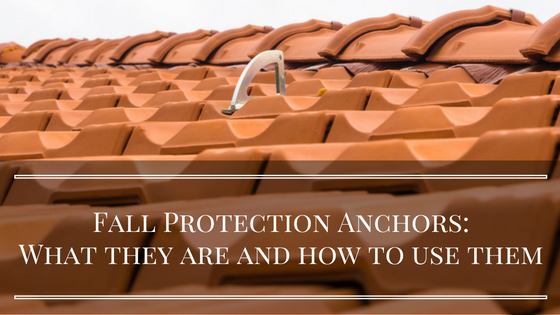
If you have ever been on a slanted roof top, dangled off the side of a high rise, or worked on a steel beam fifty stories up, then you are probably familiar with fall protection anchors.
Anchors are what you connect to with a lanyard to keep you safe when working high above the ground. An anchor is attached to a structurally sound frame. Different fall protection anchors serve different purposes. For instance, a residential wood roof anchor is designed specifically for a residential wooden roof. Each type of anchor has many accessories available to create total safety for the worker.
Fall Protection Anchors:
There are fall protection anchors for residential and commercial applications on wood, steel, concrete, and pipe surfaces. If the task is off the ground, there is an anchor made for it. Permanently installed and temporary anchors are available to keep workers safe. When the appropriate anchor is in place, you then choose the correct lanyard for the job. A lanyard is what connects you to the anchor. There are several options and accessories when it comes to these life savers.
A harness connects you and your lanyard. Options include single leg shock, dual leg shock, tie back, fall limiters, and a restraint lanyard. Extensions and assemblies are also available for your protection. After choosing the proper lanyard, next comes the harness.
Choosing the correct fall protection harness for each task is crucial. The universal and positioning harnesses are good for the weekends and hobbyists. Professionals who put their lives on the line every day need something more specialized. These would include the following harnesses: Construction, Vest, Climbing, Tower, Welding, High Visibility, Retrieval, Flotation, and Fire Resistant.
Now that you are safe and secure, let us discuss the installation of the various anchors.
The first question to answer is whether you will be installing on a roof or another structure. Roofs include commercial, residential, and standing seam. Other structures would be concrete, structural steel and I-beams, metal decking, windows and doors, and parapets.
Roof:
A roof might use an anchor point that uses a single point fall arrest tie off. For a roof that cannot be penetrated, a portable dead weight anchor could be used. If your on a standing seam roof, a roof clamp or a two-way anchor is utilized.
Concrete can be somewhat more challenging, but is possible and safe with hollow core, wall bolt-ons, swivels, and drop through anchors. Steel beams are not a problem while using cables, trolley anchors, rigging clamps, and bolt-hole anchors. For metal decking the reusable v shaped anchor comes in handy along with other previously mentioned accessories.
Windows & Doors:
Windows and doors are used as anchors using a jamb anchor which requires a self retracting lifeline. Another specialty structure, a parapet, can be anchored to with a parapet anchor system that is reusable and can also be used as a fall arrest point. Last but not least is the train rail anchor point system. This device will glide smoothly on US train rails to keep them safe while working on a high train track bridge.
As you can see there are many options in the world of fall protection anchors. The many men and women who take on these dangerous tasks can rest assured that they will stay safe while correctly using the available anchors, lanyards, and harnesses; be safe everyone.

You know your stuff, thank you!
You already know this, but I wanted to add this for future readers. A fall protection anchor must be rated for at least 5,000 lbs. Determining that is another ball game though.